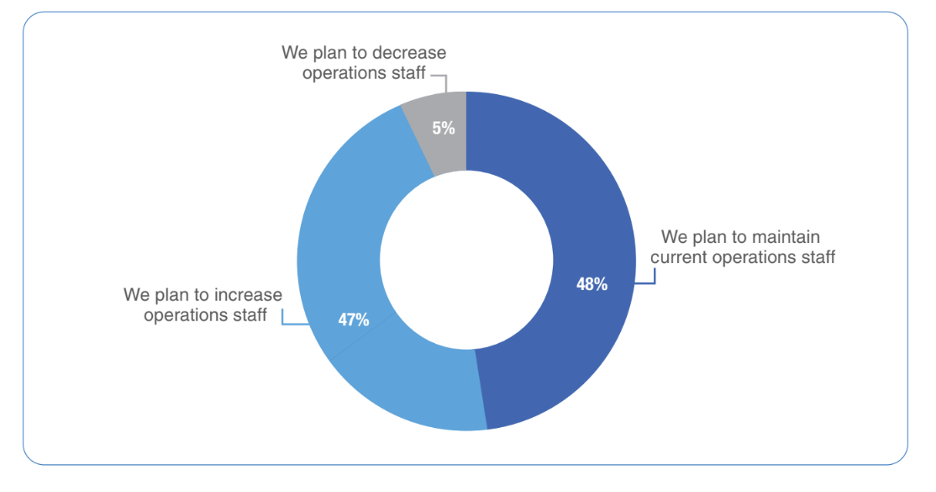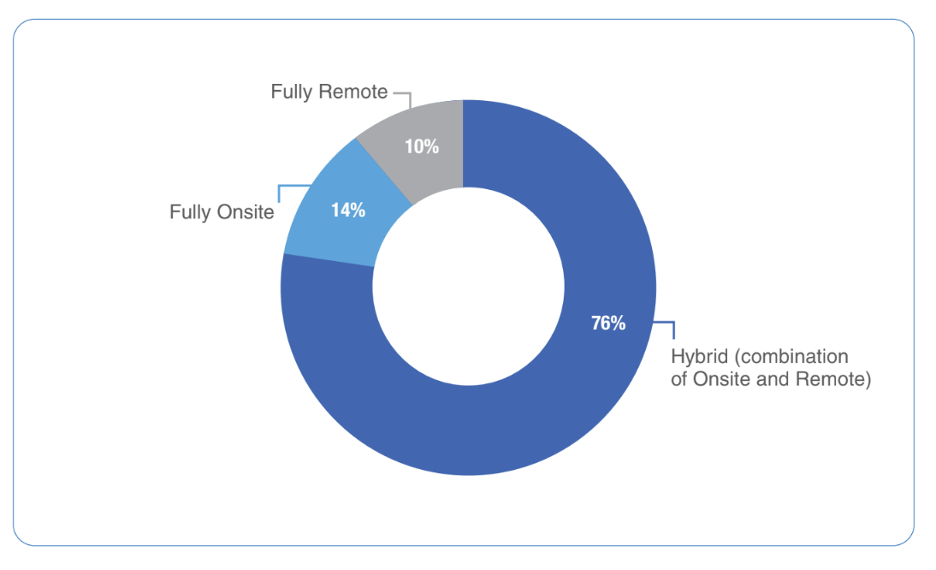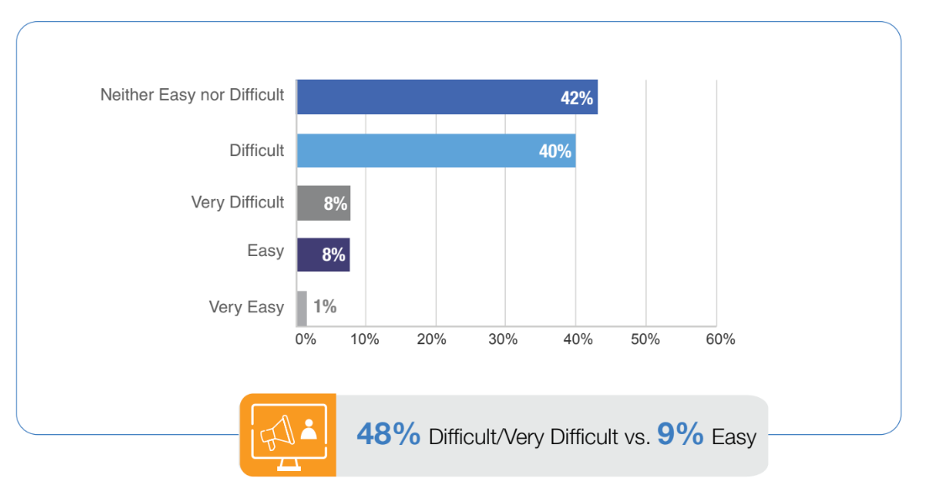Operations Council recently held a webcast panel discussion on the 2024 State of Operations Talent Study Results.
Our expert panelist included Billy Lawder. Billy is the CEO of Peloton Consulting LLC, a operations and executive consulting firm that also provides fractional COO services. Prior roles for Lauder included Chief Operating Officer of Peak Technologies and different operations roles at Home Depot, Simmons Bedding, and Anheuser-Busch. Billy earned a Bachelor of Industrial and Systems Engineering from Georgia Tech and an MBA from Kennesaw State with a PMP and Six Sigma Black Belt certifications. Moderated by Neil Brown, Operations Council COO.
During this discussion, Billy and Neil discussed several key predictions for operations talent in 2024. If you are interested in learning more, view the full webinar archive video here. Following are some of the study and panel highlights.
What are your organization’s hiring plans for operation staff in the next 12 months?

Neil: This was the survey results. Only 5 % planned to decrease hiring. This was in comparison to 6% in 2023. 48% planned to maintain; it was the same as 2023. And 46% intend to increase hiring versus 47% in 2023. Very similar results for 2024 versus 2023.
Billy: What you hear everywhere AI, AI, AI, especially in operations. What I’ve seen in my experience is there’s a lot of talk and maybe a little bit of experimentation, but still a low value to investment potential so far. Meaning that companies are still trying to figure it out while it’s amazing to go get a paragraph on chat GPT, for example, it’s harder to replicate an actual job. So, on that front, I think there’s room across the board. I really haven’t seen much of any real implementation as much as I’ve been looking. And I think from a coaching and a guidance standpoint is don’t try to build a rocket ship to Mars, but where are those opportunities, whether they’re customer service reps that are just doing the same copy and paste that you can redeploy those hours elsewhere and maybe some of and mitigate some of those increases. The other real piece to call out here is and I heard an interview from the FedEx CEO, and he pretty much said “look, we’ve all been through the COVID down, the COVID up, the COVID boom, the COVID bust, afterwards, supply chain, the same type of thing. But if you take out all four of those last four years, and you just kind of say, we’re going to go from before to after.”
So, I think lots of spots that may be decreased over the last year, that increased the previous year, maybe feeding into some of that increased plan for this year as the market starts to come back up to normal. I also think a lot of people are on the sidelines saying this election is going to be divisive and let’s wait and see how it shakes out. Plus, we just had an interest rate reduction for the first time in years the other of just last week so that could be impinging on hiring plans as well.
What will be your work environment plans for 2025?

Neil: This is the national survey. Hybrid work is the new normal. We all know that. With the majority, 76% hybrid of onsite and remote. Oddly in just last year, hybrid was only 55%. There was an article in Wall Street about how CEOs prefer 100 % on-site, not a surprise, so on-site was 14%. And only 10% fully remote.
Billy: As you saw from the big announcement last week with Amazon mandating everybody back to the office, I’ve worked with companies like an AT&T that went to more of a return to resume type mandate last year. Operations has been kind of different role. Everybody packed into cubes, everybody out on the warehouse floor. A lot of that mandated by the physical aspect. What I’ve really seen companies struggle with is not where people sit, but to what to measure and how to make it to the targets. So, setting a clear vision, cascading that through their teams is key.
I think you saw a lot in terms of the feedback that Amazon got very publicly of “you can call us back, but you can also go find somebody else.” And I’m just not interested in working like that. I am a big proponent of face-to-face meetings. I think on the flip side of that is if you’re going to downsize your facility footprint, allow some of that money to come back for travel, and be more open to having team meetings, team work sessions, even if they’re not super formal, but allowing for that fluid space and time is really good idea.
I think this could be industry specific too, because labor, for example, if you have a factory and you have laborers, they need to be on the factory floor. That’s 100 % on site. Versus service firms, professional services where you can be remote. So, potentially industry specific as well but the 100 % remote is no question is decreasing. And then we hear these mandates about onsite, whether it’s Amazon or any company that Elon Musk owns to Goldman Sachs, you’re onsite or you’re out.
How difficult is it to find and/or recruit operations talent for your organization?

Neil: Most say neither easy nor difficult, followed by difficult for 40% and very difficult for 8%. So, the combination there, 48 % is difficult, versus the combination of easy, very easy, only 9%. So most saying not easy or difficult, but still some saying that it’s difficult.
Billy: I think the challenge is that it is not necessarily finding the number of people. There are more people out there today looking for jobs than there were several years ago. Kind of per the stats up there and their great resignation. But what we’ve seen is kind of a disconnect in terms of how the inflation has rippled through the economy. The reality is operations, the costs just don’t go flying up as fast as, you know, even a revenue side and a good market can go up. So, it is, it’s feeling that punch in the middle. And that’s I think why we as operators are feeling that it’s harder to hire, meaning it’s harder to get the folks that we want at the price point that we want.
Which operations functions are the most challenging to recruit for in your organization?

Neil: Executive director level leads all at 25%, followed by project management at 24%. I see tiers in this graphic. So executive, project management, other are in a top tier followed by labor product development, admin, engineering, and another tier. then, so that’s one aspect, labor at 16%, data analysts 13%, AI made the list at only 8%. In 2023, 2023, we did not have an executive director level, so this was added this year, and then it, of course, percolated to the top. So that’s an interesting dynamic.
Billy: I’m a little bit honestly surprised by the graphic and the feedback from what I’ve seen in the industry and then talking with different recruiting contacts working in to companies. The amount of senior talent is not really the issue. But what I’m seeing, if you look across from a market standpoint, you see a lot of organizations trying to cut, not by taking that bottom layer out, but taking, kind of flattening one layer down. It’s more finding good frontline folks that really want to come to work either virtually or in person at the right price for both sides.
Which of the following benefits or perks do you offer to attract and retain operations talent?

Neil: We’ve got two years in a row now, company, culture, and employee engagement leading all, which I suppose it’s not surprising. Culture and engagement was 81% this year, but it was at 69% in 2023. This is followed by comprehensive benefits package at 76%. This was 41% in 2023. So, all the numbers were lower last year.
There’s a second tier here of competitive salary and hybrid and remote work options that are also salary 67%. It was only 50 % in 2023 and hybrid remote 63%, 44 % in 2023. So everything has grown.
Billy: I guess the first thing from a pay standpoint, kind of being below culture, generally if you get a pay raise or a bonus, it’s once a year and the other 50 something weeks plus a year, it’s back to normal, right? You know, the raise or the bonus sets in, you’ve already spent it your head and you keep moving. So, I wanted to level set here maybe just a bit on culture versus happiness. So, a culture is more of a set around the purpose, common beliefs.
I think it really comes down to the leaders setting the tone, building the trust, and actively investing in those people. Whether they’re remote or in person, I’ve seen it time and time again, handwritten notes, flowers at the hospital for a sick kid, the extra kind of quietly behind the scenes coordinated assistance for somebody in need, get well boxed the cookies shows up at your house or boss/team that was really invested the time with those associates means far more than like a high five or pizza lunch. The active investment in the associate for the rest of the year makes a huge difference in that the way thank you has said.
I want you to watch Simon Sinek Navy SEALs Trust versus Performance and it’ll highlight why the SEALs pick folks that are much higher at a trust level and much higher relationship level than they are even an execution level.
To view the complete webcast panel discussion, click here.
To download the full study report, click here.



0 Comments